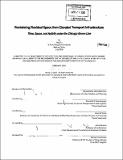Reclaiming residual space from elevated transport infrastructure : time, space, and activity under the Chicago Brown Line
Author(s)
Su, Jing, S.M. Massachusetts Institute of Technology
DownloadFull printable version (23.29Mb)
Other Contributors
Massachusetts Institute of Technology. Dept. of Urban Studies and Planning.
Advisor
Kenneth E. Kruckemeyer and Anne W. Spirn.
Terms of use
Metadata
Show full item recordAbstract
This thesis studies the non-transport functions of the residual space generated by elevated transport infrastructure and its relationship with abutting neighborhoods The space under the Chicago Brown Line, among all other elevated train lines, is often considered as an undesirable and useless urban eyesore. As part of the transit authority's right of way, such space is usually labeled "mass transportation corridor" on planner's land use maps. However, more careful observations reveal that a considerable portion of the land underneath the train tracks has been actively used by the adjacent residents or business owners for a variety of purposes other than providing transit service. These observations place an interesting question mark on the stubborn negative common perception of the residual space associated with the elevated train lines and other large scale transport infrastructure: why the fact that such residual space is actually being used cannot change the notion that it is not usable? By categorizing the observed activities under the Brown Line into private, quasi-public, and public use types, it is clear that most of the spontaneous reclamation actions are intended for private activities. (cont.) This in a sense indicates that private activities have limited contribution to the entire image of the social character of the residual space. Analysis of the physical characteristics of the residual space shows that although the physical condition of a given plot of residual space does not determine the occurrence of activities on it, the quality of the physical environment is an important factor of the quality of the social activity. Therefore, this thesis argues that one effective way to reclaim the residual spaces both physically and psychologically is to showcase a series of key projects that transform them into delightful places well-programmed for public/quasi-public activities. Following this argument, the main body of the thesis explores strategies of reclaiming the residual space by presenting cases of similar practice in other places and proposing implementation prototypes designed for the Brown Line. The lessons learned from the case studies and the design exercises are conceptualized into guidelines that cover a broad range of considerations from engaging participants, programming activities to spatial design and temporal planning. (cont.) In all, this thesis attempts to provide alternative view points for the transit authority to upgrade, manage, and maintain its right of way, to urge city planners to look into flexible and overlapped land use patterns, and to express my strong belief in good urban environment.
Description
Thesis (S.M.)--Massachusetts Institute of Technology, Dept. of Urban Studies and Planning, 2005. Includes bibliographical references (p. 95).
Date issued
2005Department
Massachusetts Institute of Technology. Department of Urban Studies and PlanningPublisher
Massachusetts Institute of Technology
Keywords
Urban Studies and Planning.